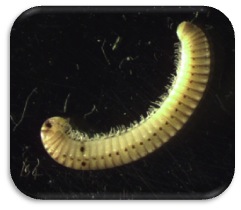Millipede, Diplopoda
Contact
Katharine Ordway Natural History Study Area9550 Inver Grove Trail Inver Grove Heights, MN 55076 651-455-6204 (On Site)
651-696-6230 (On Campus)
andersonm@macalester.edu
Biotic Inventory: Documenting Diversity at the Katharine Ordway Natural History Study Area
Diplopoda: The Millipedes

A juvenile specimen of unknown species
Potential Taxonomies
Kingdom Animalia
Phylum Arthropoda
Subgroup Myriapod
Class Diplopoda
Subclass Chilognatha
Infraclass Helminthomorpha
Order
Polyzoniida (4 families)
Platydesmida (2 families)
Siphonophorida (3 families)
Stemmiulida (1 family)
Chordeumatida (~32 families)
Callipodida (4 families)
Julida (16 families)
Spirobolida (10 families)
Spirostreptida (11 families)
Polydesmida (~28 families)
Siphoniulida (1 family)
Kingdom Animalia
Phylum Arthropoda
Subgroup Myriapod
Class Diplopoda
Subclass Chilognatha
Infraclass Pentozonia
Order
Glomeridesmida (1 family)
Glomerida (3 families)
Sphaerotheriida (2 families)
Kingdom Animalia
Phylum Arthropoda
Subgroup Myriapod
Class Diplopoda
Subclass Penicillata
Order
Polyxenida (4 families)
The following are potential taxonomic classifications for a millipede specimen of unknown species.
Common names: millipedes, thousand-leggers, and thousand-legged worms.
Overview and Diplopoda Classification
The Diplopoda (the millipedes) are made up of fifteen orders, 148 families, and an estimated 80,000 species, but only about 10,000 have been described. , They are of the phylum Arthropoda, which are classified as animals possessing bilateral symmetry, a reduced coelom, a complete digestive system, an open circulatory system, and a hard and jointed external skeleton (the chelicerates, crustaceans, insects, and myriapods are subgroups of this phylum). The millipedes—along with the centipedes—are further classified into the subgroup Myriapoda, which means “many feet.” The Myriapoda possess long bodies made up of numerous similar segments and can range in length from three to 270 millimeters.5,1 They possess pairs of antennae and eyes on the head, are active at night, and hide under leaf litter and rocks during the daytime.5
The millipedes are distinguished from the centipedes by their morphological characteristics, behavior, and diet. Whereas centipedes possess a single pair of legs on each of their body segments, millipedes have two pairs of legs on each segment for a total of about 250 pairs.5 Centipedes are predatory, fast moving carnivores that utilize venom to paralyze their prey. Millipedes consume decaying vegetation and, though slow moving in comparison to centipedes, are usually adept burrowers.3
Millipedes have been present on earth for over 400 million years.4 Having evolved in the Silurian period of the late Paleozoic era, modern millipede forms are the oldest terrestrial arthropods still in existence.3 Their importance to ecology is significant, since they are one of the most efficient decomposers of wood and leaf litter in deciduous forests, and they replace earthworms for this purpose in tropical regions.4
Diagnostic Characteristics
General Diplopoda Morphology
The millipede body plan consists of two sections: an anterior head and a long posterior trunk that is comprised of numerous, similar segments.4 Adult specimens have two pairs of legs on most segments, though the first and last segments are legless.3 The number of legs can range from twenty-two to 750 (eleven to 375 pairs). In fact, millipedes have the greatest number of appendages of any known specimen.3 It is speculated that the fusion of adjacent body segments in the embryo, which forms diplosegments, actually gives millipedes a selective advantage in burrowing since the possession of two legs on each segment allows for greater pushing force.3
A hard exoskeleton is another defining characteristic of the millipedes. They must molt this calcified skeleton as they grow; each time, a new layer of chitin, proteins, and waxes has already been secreted to form a new skeleton before the old one is shed.5 The skeleton serves as a protective measure against predators, helps to support the millipede’s body weight, and conserves water.5
Millipedes also possess a pair of antennae and Tömösváry organs (located at the base of the antennae), which allows them to sense the surrounding environment. Most millipedes have simple eyes located on the sides of the head but some cave dwelling species have lost this feature altogether.4
Differentiation between millipede sexes is fairly easy. The males appear to lack a pair of legs on either the seventh or the last ring of the body.4 In some species, these legs are folded up into the body to form sex structures known as gonopods. Female sex organs, called cyphopods, are located behind the second pair of legs.4
Distinguishing Characteristics
Subclass Chilognatha
• Calcified exoskeleton
• Setae (stiff, bristle-like structures) evenly distributed across the body
• Direct contact between males and females is required for reproduction3
Infraclass Pentozonia
• Short and broad bodies
• Males possess telopods—clasping structures that replace the last set of legs3
Infraclass Helminthomorpha
• Long, worm-like bodies
• Legs on segment seven and sometimes eight are replaced by gonopods3
Subclass Penicillata
• Soft body due to a non-calcified exoskeleton
• Setae in clumps
• Reproduction can occur without direct contact between males and females3
Characteristics of Orders Common to Minnesota and Wisconsin
Order Spirobolida (southern Wisconsin)
• Body consists of 35 to 60 segments and is smooth and round
• Segment seven contains gonopods in the place of both pairs of legs
• Mid to large body size3
Order Callipodida (southern Minnesota)
• Body consists of 40 to 60 segments and is often ridged and round
• Segment seven contains gonopods in the place of the anterior pair of legs3
• Spinnerets (organs that produce threads of silk) are located at the terminal end of the body3,
Ecology
Diplopoda are most abundant in tropical regions and deciduous forests. They can also be found in harsh climates at high elevation or in desert regions.3, Preferring moist or humid environments, millipedes spend much of their time underground or hidden under rocks and leaf litter. They are all ground dwelling and excellent burrowers. Millipedes utilize three different methods of burrowing: wedging (moving the head in an upward fashion to push away dirt); bulldozing (directly pushing into the ground head first); and boring (only utilized by millipedes having increasingly wider body segments towards its posterior end).3
Millipedes are nocturnal and most frequently feed on decaying plant matter.7 Some species have been known to be carnivorous (eating decaying snails, earthworms, and insects) or to eat the roots and leaves of living plants, often resulting in damage or death to the plant.2,1 Though their mouths usually consist of two parts that are designed for chewing, some species possess long, tubular mouthparts that allow them to suck nutrients from food.3 One cave dwelling, semi aquatic species that was discovered in Italy feeds on clay and limestone particles from streams.3
Lacking sharp teeth or any fatal defense mechanism, millipedes are relatively harmless to humans. They coil into a tight ball when disturbed and sometimes secrete foul-smelling chemicals via glands on the side of the body.1,7 A few brightly colored species can secrete cyanide, and other tropical species have the ability to project secreted fluids up to half of a meter.1
Life History
Diplopoda development consists of metamorphosis between the larval and adult forms. Adult Diplopoda pass the winter in protected environments and mate in the spring.8 Females lay between twenty to thirty eggs in warm soils, though some species give birth to live young.8,2 Only the orders Platydesmida and Stemmiulida exhibit brooding of the eggs.3 The larvae are anamorphic: they initially lack legs but soon molt into stage one of development (consisting of six segments and three pairs of legs).3 In total, millipedes evolve over about seven stages for a total development period of between twenty-one to twenty-five weeks.8 Each time they molt, the young millipedes grow more body segments and pairs of legs until the adult form is reached.1 Though this process occurs fairly quickly, millipedes don’t reach sexual maturity until two to five years after physical development.8 Millipedes can live as long as seven to ten years.1
Distribution
Though millipedes are distributed worldwide, they are most frequently found in tropical regions. Two species of Diplopoda, the Scolopendra heros and Orthoperus ornatus, are abundant throughout the southern United States and Mexico.6 Around 52 families and 914 described species are distributed across the U.S. and Canada, but these numbers are probably an underestimation since many species have yet to be described.1 Many orders occur across multiple continents. Species of the order, Glomerida, for example, can be located throughout Europe, North Africa, Asia, and North and Central America.3 Other species are found in such places as Australia and New Zealand, the Indian Ocean islands, the Caribbean, the Mediterranean, and Northern Canada.3 With such a wide variety of species and long history of evolution, it is no surprise that the Diplopoda are found in practically every geographic location.
Voucher Information
The unidentified Diplopoda specimen that is shown at the topic of this webpage was collected at the Katherine Ordway Natural History Study Area in Inver Grove Heights, Minnesota. It was uncovered from an area of moist leaf litter next to a flowering plant.

1. Bug Guide. 2010. http://bugguide.net/node/view/37#habitat
2. Millipedes. 1991. Ohio State University. http://ohioline.osu.edu/hyg-fact/2000/2067A.html
3. Centipedes and Millipedes with Emphasis on North American Fauna. 1999. http://www.emporia.edu/ksn/v45n3-march1999/millipedes-1.htm
4. Introduction to Millipedes. 2005. The Field Museum. http://www.myriapoda.org/milliPEET/introduction.html
5. Starr, Cecie, Ralph Taggart, Christine Evers, and Lisa Starr. Diversity of Life; Biology: The Unity and Diversity of Life, Twelfth Edition. Brooks/Cole: Belmont, 2009.
6. spinneret. 2010. Merriam-Webster Dictionary. http://www.merriam-webster.com/dictionary/spinneret
7. Centipedes and Millipedes. 2010. Arizona-Sonora Desert Museum. http://www.desertmuseum.org/books/nhsd_centipede.php
8. Centipede, Millipede. 1999. Texas A&M University. http://insects.tamu.edu/fieldguide/cimg379.html
Compiled by Stephanie Vilendrer.
Biodiversity & Evolution (BIOL 270) Professr Sarah Boyer. Spring 2010.
Specimen collected at Macalester College’s Katharine Ordway Natural History Study Area on April 15, 2010.